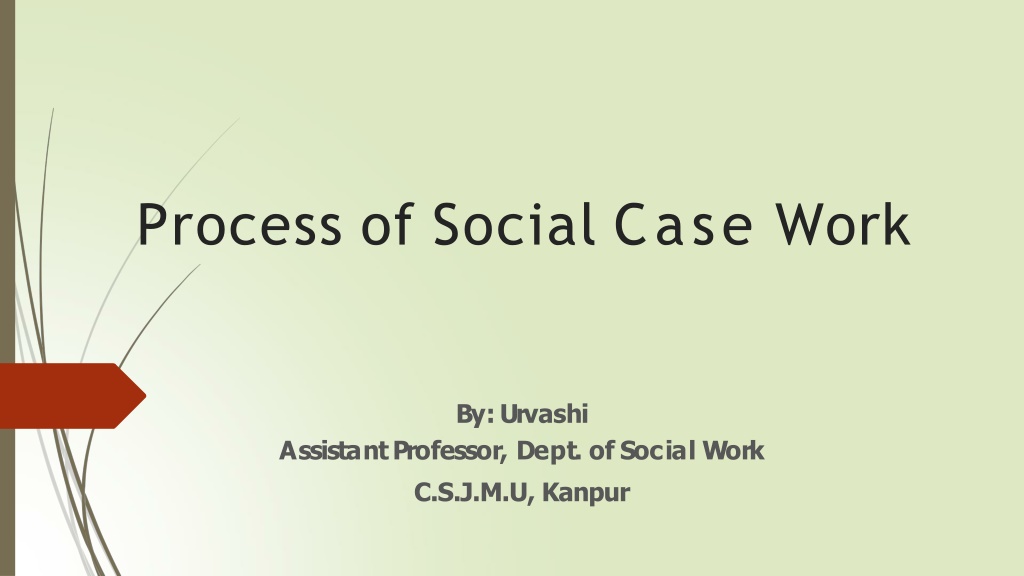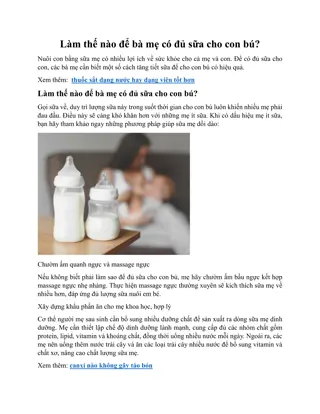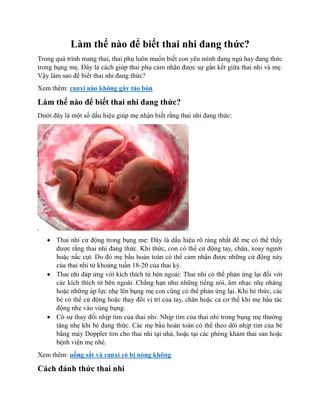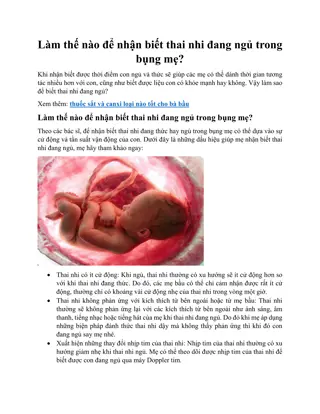Understanding the Process of Social Case Work in Social Work Practice
Social case work involves a systematic process where a client seeks professional help through a case worker. This process begins with intake, where the client's needs and problems are assessed, followed by a psycho-social study to understand the client's adaptation to stress. The case worker probes various aspects of the client's life such as personal resources, defense mechanisms, motivation, and family dynamics. Perlman's framework guides the study by focusing on the presenting problem, its significance, causes, coping efforts, and desired outcomes. The interview schedule includes history of the problem, personal and family history, problematic areas, and treatment plan formulation.
Download Presentation

Please find below an Image/Link to download the presentation.
The content on the website is provided AS IS for your information and personal use only. It may not be sold, licensed, or shared on other websites without obtaining consent from the author. Download presentation by click this link. If you encounter any issues during the download, it is possible that the publisher has removed the file from their server.
E N D
Presentation Transcript
Process of Social Case Work By:Urvashi AssistantProfessor, Dept. of Social Work C.S.J.M.U, Kanpur
I ntake ? Client comes to an agency for professional help through a Case worker. ? Relationship between two persons of unequal positions and power is developed. ? Respect the client s personality and help him resolve. ? Accept client as a person in a stressful situation ? Caseworker who will be suitable to help the person.
The areas for probing are: ? The stage of the problem at which the person, through whom, and the reasons becauseof which,comesto this agency. ? The nature of request and its relation to his problem, and the cause of his problem,as the clientsees. ? Does the requestrelatedirectlyto his needs/ problems. ? His adjustment to his socialfunctionsin job, family,etc. ? Thestate of his physicaland mentalhealth. ? His appearance includingdress, etc.in his first meeting.
The areas for probing are continued. ? His personaland social resourcesincludingmaterialand financial position. ? Appropriatenessand intensityoffeelings. ? Natureof defensemechanismshe frequentlyuses. ? Level of motivation,howquicklyhe wantsto get rid of his problems. ? Natureof family, itsstatus, values, relationshippattern withinthe family,etc. ? Reactions to the worker and seeking help from the agency and sex of caseworker who willbe suitableto help the person.
Psycho-Social study ( Exploration / Investigation): Psycho Social study is the initial assessment of client s current, relevant past and possible future modes of adaptation to stressful situations and normal living situations. The tools used by the case worker for collectingthe relevant information are: 1. Interview guide and schedule. 2. Life chart. 3. Video
Perlman has given the following contents of the case work study: Thenatureof the presenting problem Thesignificanceof the problem. Thecause(s),onsetand precipitantsof the problem. Theeffortsmadeto cope with problem-solving. The natureof the solutionor ends sought from thecase workagency. The actual natureof the agencyand its problem solvingmeansin relationto the clientand his problem.
The Format of Interview Schedule: ? History of the problem. ? Personal history. ? Familyhistory. ? Problematic areas. ? Treatment Plan
Psycho - Social diagnosis (Assessment): Perlman (1957) Diagnosishelpsindeterminingthefocus oftreatment,further collection offactsand deciding thebestcourseofactiontosolvethe problem. ? Social diagnosis is the attempt to arrive at an exact definition as possible of the social situation and personality of a given client. ? Diagnosis is concerned with understanding both the psychological or personality factors which bear a causal relation to the client s difficulty and the social or environmental factors which tend to sustain it.
Psycho - Socialdiagnosis( Assessment)conti. ? Diagnosis assessment of the important relationships. may be viewed as the fluid, constantly changing client, their problems, life situations and ? History of the problem. ? Personal history. ? Familyhistory. ? Problematic areas. ? Treatment Plan`
Content of the Social Diagnosis: ? T he nature of the problem brought and the goals sought by the client, in theirrelationship to. ? The nature of the person who bears the problem and who seeks or needs help with the problem, in relation to. ? Thenature and purpose ofthe agency and the kind ofhelp itcan offer and/ or make available.
Process of making diagnosis: ?Shifting the relevant from irrelevant data ? Organizing the facts and getting them into relatedness ? Grasping the way in which the factors fittogether ? Preparing the meaning as a whole.
Typesofdiagnosis: ? Clinical: Theperson isdescribed by the nature of the illness.E.g. schizophrenia, psychopath, typhoid, etc. Used inmedical practice. Use isminimumiscase work practice. - Importance in medical and psychiatry. ? Etiological: Triesto delineate the causes and development of presenting difficulty. History ofperson. Limitation- doesn tlook into present.
Types of diagnosis. ? Dynamic: Properevaluation of the client s current problem as he isexperiencing it now. Role of psychological, biological, social and environmental factorsin the causation ofthe problem. No attemptto dig life history. Case workerand client engage in appropriatecorrective action or treatment. These developments may lead to modifications in the goals fortreatment.
Data forDiagnosis: Interviews Checklist and Inventories Direct Observation
Stepsin Diagnosis: The worker begins to focus on problematic behaviours. Both functional and ? dysfunctional behaviours in the client s environment are surveyed. The client s personal strength as well as of his environment are evaluated. He specifies the target behaviours. Break down complex behaviours intoclear and ? precise component parts. Baseline data are collected to specify those events that appear to be currently ? controlling the problematic behaviors. The collected information issummarizedin an attempt to anticipate any major problem ? in treatment and as a way of beginning to establish objectives fortreatment. Selecting priorities fortreatment isthe final step of the diagnosis. ?
Intervention/Treatment(Problem-solving process): Hamilton, Treatment is the sum total of all activities and service directed towards helping an individual with a problem. The focus is relieving of the immediate problemand,iffeasible,modifiesanybasic difficulties whichprecipitatedit.
The objectivesofsocialcase work treatmentare: ? T o preventsocial breakdown. ? T o conserve client s strength. ? T o restore social functioning. ? T o provide happy experiences to the client. ? T o create opportunities forgrowth and development. ? T o compensate psychological damage. ? T o increase capacity forself-direction. ? To increase hissocial contribution.
Methods of Social treatment: ? Administration of concrete and practical services. E.g. money, medical care, scholarships, legal aid, etc. ? Indirect treatment (modification of environment, both physical and social). E.g. camps, group experience activities, training programmes, etc.
Methods of Social treatment ? Direct treatment: Counselling marriage, occupational, family,school, etc. Therapeutic Interviewing family and maritaltherapy. Clarification Interpretation and Insight Psychological support. Resource utilization Environment modification.
Monitoring and E .valuation: Monitoring provides crucial feedback to case worker and the client regarding: 1. Whether the treatment programme is succeeding as desired. 2. Whether established goals have been achieved. 3. Whether modifications in the programme are necessary. 4. Whether the client is being helped in real sense.
Follow-up and Te .rmination ? At the end, i.e. termination, the worker should discuss the original as well as revised goals and objectives, achievements during the helping period, factors helpful or obstructive in achieving the objectives, and the efforts needed to maintain the level of achievement and the feelings aroused by disengagement. ? Termination of the helping process brings up in both the case worker and client(s) many feelings both positive and negative which must be verbalized and discussed.
Follow-up and Termination.. . ? Follow-upis done to help clientmaintain theimprovement. ? Duringfollow-up,the clientis helped to discussthe problems he faces in maintainingthe improvement. ? Work is done with the people significant for his improved social functioning. If required,he is referred to the proper sourcefor needed servicesand help. ? The follow-upshouldbe plannedon a diminishingbasis after
References Gordon , Hamilton,(1940) Theory And Practice Of Social Case Work: Columbia University Press.: New York School of Social Work Hollis, Florence (1964) Case Work - A Psychosocial Therapy, Random House, NY Mathew, Grace (1992) An Introduction to Social Case Work Bombay; Tata Institute of Social Sciences, Mumbai Misra. P.D. (1994) Social Work: Philosophy and Methods. InterIndia Publications, New Delhi Perlman, Helen H (1973) Social Case Work - A Problem solving process, University of Chicago Press, Chicago. (16th) Robert, & Robert Nee (1970), Theories of social case work, (ed) University of Chicago Press,Chicago. Samalley, Ruth Elizabeth (1971), Theory of Social Work Practice; Columbia Univ.press, NY. Sundel and Sundel (1999) Behaviour Modification in the Human Services, Sage, Newbury Park. Timms, Noel (1964), Social Case Work : Principles and practices, Rutledge and Kegan Paul., London Trevithick (2005) Social Work Skills, A Practice Hand Book, Open University Press, London. Upadhyay, R.K (2003) Social Case Work, Rawat, Jaipur























